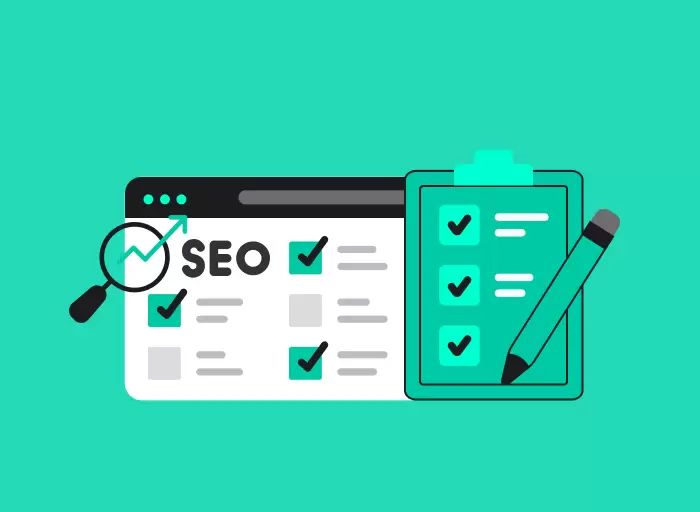Essential Website Redesign SEO Checklist To Avoid Ranking Loss
Redesigning a website is a crucial move in any brand's online journey, with far-reaching implications for SEO. It's an opportunity to refresh and modernise, align more closely with evolving business strategies, and ensure your digital presence continues to engage your audience effectively.
However, without a careful approach, it's also a moment when you could inadvertently dilute the SEO equity you've built up over time.
This checklist is your guide to navigating the complexities of a website overhaul, ensuring that every update contributes positively to your site's search engine standing, and securing the value of past SEO efforts while laying a stronger foundation for the future.

If you're wondering how to redesign website without losing SEO, you've come to the right place.
Why Is There a Need for Website Redesign?
Failing to keep up in the rapidly evolving online landscape can set you behind. Here's why redesigning your website matters:
Design Evolution
Website design trends are constantly changing. What was considered modern and appealing a few years ago may now appear outdated and unattractive. This is not merely a matter of aesthetics; it also affects how users perceive your website's credibility and trustworthiness.
An outdated design can make visitors question the relevance and reliability of your website's content. Therefore, a website redesign ensures that your site looks contemporary and aligns with current design conventions, making it more appealing and trustworthy to users.
User Expectations

User experience (UX) plays a pivotal role in the success of a website. As the online landscape evolves, so do user expectations. Users today demand websites that are easy to navigate, load quickly, and provide a seamless and enjoyable browsing experience.
If your website falls short in any of these aspects, visitors will likely bounce away to competitors. Redesigning your website with a focus on user experience ensures that it meets the evolving expectations of your audience, keeping them engaged and satisfied.
Search Engine Updates
Search engines like Bing and Google are constantly refining their algorithms to deliver high-quality search results to users. If your website doesn't keep pace with these updates, it can experience a drop in search engine rankings. This can have a significant impact on your website's visibility and organic traffic.
A website redesign involves optimising your site to align with the latest SEO best practices and algorithm changes, ensuring it remains competitive in search engine results pages (SERPs).
Business Changes
Businesses are not static entities; they evolve. You may introduce new products or services, target different customer segments, or expand your geographical reach. If your website fails to reflect these changes, it can confuse your audience.
Outdated information or misaligned messaging can deter potential customers and harm your brand's credibility. A website redesign allows you to update and realign your digital presence with your current business goals, ensuring that it accurately represents your offerings and mission.
Technological Advancements
The technology landscape continually advances, influencing how websites function and users access them. For instance, the proliferation of mobile devices has made mobile-friendliness and responsive design essential.
Failure to adapt to these technological shifts can result in a poor user experience on specific devices or browsers. A website redesign is an opportunity to ensure that your site remains compatible with modern technology and accessible to users on various platforms, from smartphones to desktop computers.
Local Relevance
Local relevance is paramount, especially for those targeting local customers. Search engines take into account a user's location when delivering search results. If your website lacks localisation features or content tailored to local audiences, it may struggle to appear in relevant local search results.
A website redesign focusing on local SEO optimisation ensures that your digital footprint aligns with the preferences and needs of your local customer base, giving you a competitive edge in the local market.
Website redesign is a multifaceted response to the dynamic nature of the internet and the evolving expectations of users and search engines. It involves more than just a facelift; it's a strategic endeavour to keep your website relevant, user-friendly, and aligned with your business goals, while also ensuring that it ranks well in search results and caters to the unique needs of your target audience.
Avoiding website redesign mistakes destroying SEO is crucial during this process.
Website Redesign SEO Checklist

Embarking on the journey of a website redesign without a comprehensive SEO roadmap is akin to setting sail without a compass. Such an oversight can steer you far off course in your quest for digital relevance.
The checklist outlined below acts as a navigational aid, charting a course that safeguards the integrity of your SEO throughout the tumultuous process of redesign. Each item on this list represents a crucial checkpoint, ensuring that with each step of the redesign, your website's SEO foundation remains robust and poised for enhanced performance.
1. Assessment of Current SEO Performance
Before you start changing your website, it's essential to understand how well it's currently doing in search engines like Google. This is like checking the condition of a car before you decide to upgrade or modify it.
What to check:
You should look at three main things:
Keyword Rankings: These show how well your website appears in search results for different words and phrases.
Organic Traffic: This measures how many people visit your website through search engines.
Backlinks: These are like recommendations from other websites, affecting your website's reputation.
Why it matters:
By doing this assessment, you create a starting point. It's like marking the level of water in a pool before you start filling it. This starting point helps you track how much your SEO improves after the redesign.
For Australian businesses:
If you're in Australia, you should also look at how well you're doing locally compared to your competitors. It's like knowing who your neighbours are and how your house compares to theirs. This local insight helps you make smart decisions during the redesign, ensuring that your website remains near the top of Google's search results.
2. URL Structure and Redirection Plan
Aiming to redesign website without losing SEO can be challenging. Therefore, it's crucial to keep your web addresses or URLs consistent and accessible for search engines to understand. This is important because it helps search engines like Google find and display your web pages when people search online.
If your URLs change too much or become messy, it can confuse search engines and hurt your website's visibility in search results. So, keeping URLs clear and consistent is like giving your website a good map for search engines to follow.
Creating a Redirection Plan
During a redesign, some of your old web pages may no longer exist, or their addresses may change. To avoid confusion and maintain your SEO rankings, it's essential to create a redirection plan.
Think of this plan as a set of signposts that tell search engines where to find your new web pages when someone clicks on an old link. This way, even if your URLs change, people who visit your site through old links won't get lost, and your website's SEO rankings won't take a hit. It's like ensuring that if someone moves your house, they'll still know how to reach you by updating their address book.
Consistent and clean URLs help search engines find your website, and a redirection plan ensures that even if your URLs change, people and search engines can still find your content without any trouble. This keeps your website's search engine rankings intact and helps visitors easily navigate your redesigned site.
3. 301 Redirection Mapping

When you're changing how your website is organised, you need to make sure old web addresses (URLs) point to the new ones correctly. This is like making sure all the mail that used to go to your old address now goes to your new one when you move houses.
What It Does:
301 redirection mapping makes sure that the excellent reputation your old URLs had with search engines gets transferred to the new ones. Think of it as ensuring that your new house inherits the good reputation of your old one.
What to Focus On:
When you're doing this mapping, the key is to keep the good ranking and reputation your old web pages had. Imagine you're moving your furniture to your new house, but you don't want to lose any of it in the process. Similarly, you don't want to lose the search engine "power" your old pages had.
301 redirection mapping is like ensuring your old website addresses know how to find the new ones. This is super important because you don't want your website visitors lost. And when you're doing this, remember to keep all the good stuff your old pages had, so your website continues to do well in search engines.
4. XML Sitemap and Robots.txt File
Redoing your websites means knowing the importance of having two specific files in place: XML sitemaps and a robots.txt file. These files help your website communicate with search engines, like giving them a map and some rules to follow.
What They Do:
XML Sitemap: Think of this like a map you give to search engines. It shows them the layout of your website and which parts are the most important. This is useful, especially if you have a big online store with many products.
Robots.txt File: This is like a security guard for your website. It tells search engines which parts they can look at and which parts they should avoid. It's important to set these rules correctly.
Why They're Important:
Getting these files right is a key part of making sure your entire site stays visible on search engines. If they're not set up correctly, it's like giving search engines a confusing map. This can affect how your website shows up in search results.
5. Page Speed and Performance
How fast your website loads and how well it performs are really important. This affects two big things: how much people like using your site and how well it shows up on Google.
What They Do:
Page Speed: This is about how quickly your web pages appear on someone's screen. People want fast page load time, and Google pays attention to this, too. If your site is slow, it can affect how it ranks in Google's search results.
Website Performance: This is about how well your site works overall. It's not just speed but also how smoothly everything functions. A good website works properly, does not have errors, and gives a great experience for visitors.
Why They're Important:
People don't like waiting for slow websites, and Google doesn't want to send people to slow websites. So, if your website is fast and works well, it's better for users and better for your Google rankings.
How to Make It Better:
To make your website faster, you can:
- Put your website on servers in places that are closer to your visitors.
- Make your images smaller so they load quickly but still look good.
- Simplify the technical stuff (code) on your site.
- Use local content delivery networks (CDNs) to speed things up, primarily targeting a specific location.
Indeed, having a fast and well-performing website is essential. It makes people happy when they visit your site, and it helps your website show up higher in Google.
6. Content Migration Strategy
When you're making adjustments to your website, it's essential to consider how you handle your current content. This is important for keeping the good reputation your content has with search engines.
What It Involves:
Content Review: You need to look at everything on your website, like articles and text. Check if it's still relevant and if it works for an Australian audience. This might mean updating things like numbers or making sure your blog or video content follows Australian laws.
Local Language: If you're in Australia, it's important to use Australian English spelling and language. This helps your website connect better with local users.
How to Do It Right:
To ensure you do this right, review all your content, update what's needed, and use the right language. This ensures that your website stays competitive and trustworthy.
7. Technical SEO Audit

A comprehensive technical SEO audit should precede the relaunch of your redesigned website. This audit will uncover any issues impacting your site's ability to rank well in search engines. Pay attention to site structure, schema markup, metadata, and other on-page SEO elements.
For businesses targeting the Australian market, it's also critical to ensure that local SEO factors, such as correct business information and localised content, are up to date. Utilise a suite of SEO tools to perform this audit and address any issues immediately, ensuring your redesigned site is fully optimised for your audience and search engines.
8. Implement 301 Redirects
Once your 301 redirect plan is established, the implementation must be executed with precision. This involves setting up the redirects and rigorously testing them to ensure they work correctly. In the Australian context, where local and international search traffic can vary, it's important to monitor how these changes affect your traffic.
After implementation, regularly review the redirects for anomalies and adjust as needed to maintain performance. This will help you retain the link equity you've built and prevent disruptions to your Australian audience's user experience.
9. Testing and Quality Assurance
Thorough testing and quality assurance are the final defence against any potential SEO issues arising from your website redesign. This includes a meticulous review of all SEO elements, such as meta tags, alt attributes, and structured data. It's also critical to test the website's functionality across various browsers and devices commonly used in Australia to ensure a consistent and positive user experience.
Load testing should be conducted to ensure that your hosting can handle the Australian audience traffic, especially during peak times or sales periods. Addressing these areas before going live will help secure your site's reputation and SEO standing.
10. Post-Launch SEO Audit
After your website goes live, a post-launch SEO audit is essential to identify any issues that may impact your search visibility. This includes checking for indexation issues, validating structured data, and monitoring key performance indicators like traffic and rankings, particularly for Australian-specific queries if your market is focused here.
It's also a good time to gather initial user feedback and observe how your audience receives the changes. This audit is a continual process that helps ensure your website remains fully optimised and competitive in the ever-changing digital landscape.
Conclusion
“How to redesign a website without losing SEO†is a question many people ask.
The road to a successful website redesign can be complex and demanding, but it's a journey worth undertaking. Armed with a comprehensive SEO checklist, you can navigate this terrain with confidence, ultimately achieving higher search engine rankings and a more robust online presence.
This checklist goes beyond a mere to-do list; it represents a strategic framework for safeguarding and enhancing your website's SEO value while optimising its overall performance.
By adhering to this checklist, you mitigate the risk of losing SEO rankings during the site redesign and position your website for thriving in the fiercely competitive digital landscape. Remember that the digital realm is in constant motion, and what may be a winning strategy today could become obsolete tomorrow. Therefore, ongoing adaptation and monitoring will be critical to sustaining and enhancing your website's SEO performance in the long run.
A website redesign project is an opportunity to refresh your digital appearance and solidify your digital foundation. Aligning your website with the latest design trends, user expectations, search engine algorithms, and technological advancements ensures that it remains a valuable asset in your online presence, serving as a dynamic tool to engage, inform, and convert visitors into loyal customers.
When in doubt, consulting with a professional website designer or SEO services expert can be invaluable in achieving your website redesign goals.





